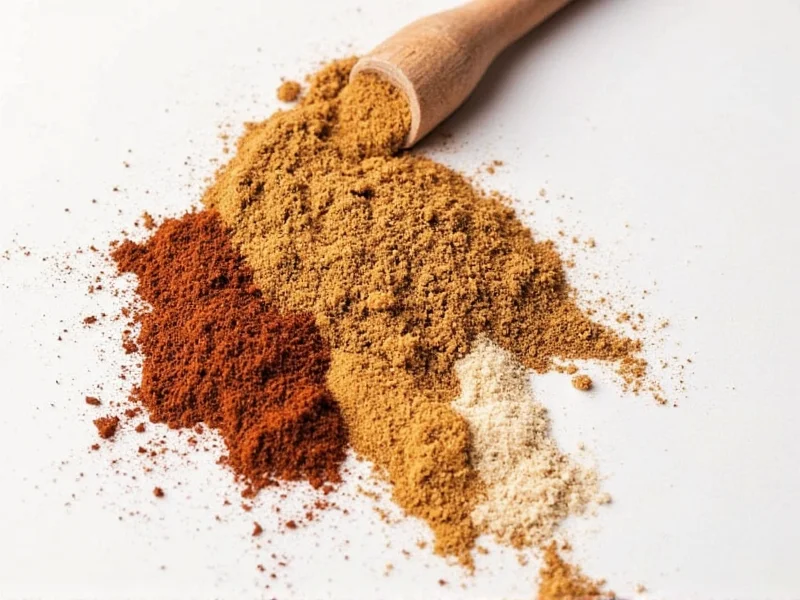Understanding which spices contain gluten is crucial for those managing celiac disease or gluten sensitivity. While the spices themselves don't naturally contain gluten, contamination risks exist throughout the supply chain. This comprehensive guide explains exactly which spices require caution and how to safely navigate your spice cabinet.
Why Pure Spices Are Naturally Gluten-Free
Gluten is a protein found exclusively in wheat, barley, and rye. All single-ingredient spices derived from plants—such as cinnamon, paprika, cumin, and turmeric—contain no gluten in their natural state. The confusion about gluten in spices typically stems from processing methods rather than the spices themselves.
How Gluten Enters Spice Products
Three primary pathways introduce gluten into spice products:
- Anti-caking agents: Some manufacturers add flour-based agents to prevent clumping
- Spice blends: Pre-mixed seasonings often contain wheat-derived ingredients
- Cross-contamination: Shared equipment in processing facilities
Spices Most Likely to Contain Gluten
Certain spice products carry higher risk due to common manufacturing practices. These include:
- Garlic powder (sometimes cut with wheat flour)
- Onion powder (similar processing concerns)
- Curry powder blends (may contain flour as filler)
- Seasoned salts (like garlic salt or onion salt)
- Chili powder blends (check for wheat additives)
- Imported spice mixes (less regulated processing standards)
| Spice Type | Gluten Risk Level | Common Gluten Sources | Safety Recommendation |
|---|---|---|---|
| Single-ingredient spices | Very Low | Natural state is gluten-free | Generally safe, but verify packaging |
| Spice blends | High | Wheat flour, maltodextrin | Require gluten-free certification |
| Garlic powder | Moderate-High | Wheat flour as anti-caking agent | Choose certified gluten-free brands |
| Curry powder | Moderate | Flour fillers in some blends | Check ingredient lists carefully |
| Imported spices | Variable | Less regulated processing | Exercise caution, prefer domestic brands |
Identifying Truly Gluten-Free Spices
When shopping for spices while managing gluten sensitivity, follow these evidence-based practices:
Read Labels Thoroughly
Look for specific statements like "gluten-free" or "certified gluten-free" rather than just "wheat-free." The FDA requires products labeled "gluten-free" to contain less than 20 ppm of gluten, the threshold considered safe for most people with celiac disease.
Understand Certification Labels
Third-party certifications provide the highest assurance:
- NSF Gluten-Free Certification
- GFCO (Gluten-Free Certification Organization)
- CAC (Celiac Support Association)
Contact Manufacturers Directly
When in doubt, call the manufacturer. Reputable companies maintain detailed information about their processing facilities and testing protocols for gluten contamination. Ask specifically about shared equipment and testing procedures.
Trusted Gluten-Free Spice Brands
Several manufacturers maintain dedicated gluten-free facilities or rigorous testing protocols. These brands consistently meet strict gluten-free standards:
- Penzey's Spices (all products gluten-free)
- Simply Organic (certified gluten-free options)
- Frontier Co-op (clear gluten-free labeling)
- Spice Islands (select gluten-free products)
- McCormick (most single-ingredient spices, but verify blends)
Testing Your Spices for Gluten
For those with extreme sensitivity, home gluten test kits can provide additional peace of mind. While not perfect, these tests can detect gluten levels above 20 ppm. Remember that testing accuracy varies, and negative results don't guarantee complete safety for highly sensitive individuals.
Creating Your Own Safe Spice Blends
The most reliable approach for strict gluten-free diets involves making your own spice blends using certified single-ingredient spices. This eliminates the risk of hidden gluten in commercial blends. Store your homemade blends in clearly labeled containers to prevent cross-contamination in your kitchen.
Regulatory Standards for Gluten-Free Labeling
Understanding labeling regulations helps identify truly safe products. In the United States, the FDA requires that products labeled "gluten-free" contain less than 20 parts per million (ppm) of gluten. The European Union and Canada maintain similar standards. Products without certification may still contain problematic levels of gluten despite marketing claims.











 浙公网安备
33010002000092号
浙公网安备
33010002000092号 浙B2-20120091-4
浙B2-20120091-4